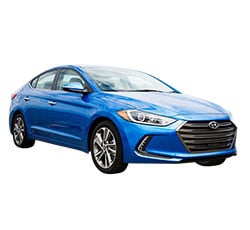2017 Hyundai Elantra Pros vs Cons

What's New For 2017
The most noticeable difference is the Elantra's sleek new body style, which is curvier and more aerodynamic. On the inside, the control stack and dash designs are more daring. There are two new engine options for this model year.
Ten Reasons You May Like the 2017 Hyundai Elantra – The Pros
1. More Economical Engine
Although the standard engine choices for the 2017 Hyundai Elantra are not as peppy as the sport engine, they yield better fuel efficiency. The standard option is a 2.0-liter engine with 147 horsepower. The 2017 Elantra averages an astounding 38 miles per gallon on the highway.
2. Quiet Ride Quality
Hyundai made several improvements for this year, and the most noticeable is the thicker glass on the doors. They also added a subframe to the suspension, put thicker carpeting on the interior and made smaller dash holes to noticeably reduce noise. Drivers who upgrade from older Elantras will feel like they are riding in a plane instead of a car.
3. Plenty Of Cargo Space
A deep and wide trunk makes it easy to haul everything from groceries and luggage to strollers and sporting equipment. There are also wider storage compartments on passenger doors and a multi-functional arm rest in the back.
4. Steering Stability And Control
Drivers who despise vague steering will love the new innovations of the 2017 Elantra. It feels stable and secure on the road regardless of wind and speed. Drivers have more control over the steering experience with a multi-choice drive selector. Normal, eco and sport options provide a more customized sense of control.
5. Loaded Safety Features
The new Elantra keeps drivers safer by alerting them when they veer out of their own lane. It also alerts drivers of vehicles in blind spots and when they are approaching cross traffic. Forward collisions are easier to prevent with a detection system and the automatic braking assistance of the vehicle. All of these features also mean more potential discounts on auto insurance costs.
6. Simplified Interface
There are still manual controls on the dash for drivers who prefer the assurance of pushing a button or turning a knob. However, the 2017 Hyundai Elantra comes with a larger touch screen that measures an impressive 7 inches. Menus are highly organized, and the intuitive system minimizes distractions for a safer ride. Brightness is adjustable to make the screen easy to see in bright light and less intrusive at night.
7. Feature-packed Trims
The Limited and Eco trims provide the most features for the price. With the Limited package, drivers enjoy everything from the door handle approach lights and push-button start to Apple Car Play and SiriusXM radio. The Eco trim is an excellent choice for automatic headlight and temperature controls and the fuel-saving Shiftronic technology.
8. Excellent Warranty
Hyundai is known for offering America's best warranty, and that is even more incentive to buy the 2017 Elantra. The powertrain warranty is good for 10 years or 10,000 miles and covers the transmission and engine. The bumper-to-bumper warranty covers most other issues and lasts for 5 years or 60,000 miles. Drivers only need to worry about maintenance costs, which are typically low for the Hyundai Elantra.
9. Easy Shifting
The new design of the control stack in the Hyundai Elantra makes it easier to reach the shifter. There is also a new shifting knob that is ergonomically designed. It has just the right combination of resistance and flow to make shifting a breeze whether drivers choose an automatic or manual option.
10. Great Versatility
With a price that is lower than most competing sedans, plentiful standard features and good fuel economy, the 2017 Hyundai Elantra is for anyone. It stands up to commuting demands for many miles with the backing of a powerful warranty. The Hyundai Elantra is full of safety features for college and high school students who are new to driving. It is also a great car for small families with its ample interior.
Reasons You May Not Like the 2017 Hyundai Elantra – The Cons
1. Average Transmission
There is nothing spectacular about the transmission of the newest Elantra. Its average functionality makes it useful. However, it shows signs of lag when accelerating quickly. The overall design contributes to fuel efficiency but does not lend to on-demand power needs.
2. Noisy Engine
The new engine design for the 2017 model leads to better fuel efficiency but not lower noise levels. Drivers will notice a louder whine every time the gas pedal is depressed and when traveling at higher speeds. The noise level is pronounced and may be annoying to drivers who have to change speeds or take surface streets most of the time.
3. Average Cabin Trim
Competitors beat Hyundai when it comes to the Elantra's standard cabin trim. Although it has plenty of beneficial features, most of the aesthetics are nothing to write home about. Drivers who are expecting a semi-luxury look for a lower trim will be disappointed. However, there are upgraded Elantra trims that compensate for these deficits if buyers are willing to pay extra.
Conclusion
The Elantra fits most budgets as a base model, and the 2017 sedan earned "good" ratings across the board from the IIHS to boast yet another Top Safety Pick+ award. Overall, the features and benefits outweigh the smaller disadvantages to make the 2017 Hyundai Elantra a good value. Its new design and upgrades promise to keep the Elantra's reputation for efficiency and dependability intact.
• Why buy a 2014 Hyundai Elantra? w/ pros vs cons.
• Why buy a 2015 Hyundai Elantra? w/ pros vs cons.
• Why buy a 2016 Hyundai Elantra? w/ pros vs cons.

